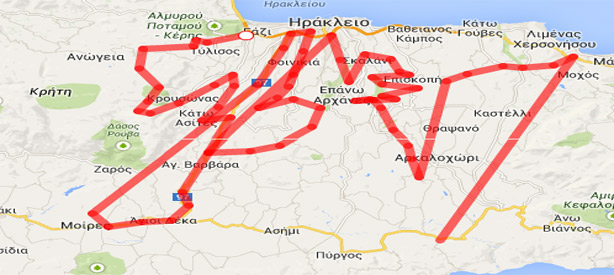The Wine Roads of Heraklion Prefecture form an integrated network of routes covering the entire wine-producing zone of Crete, including nearly all wineries open to the public.
Today the routes form a unified pilot route starting at the exits from the city of Heraklion onto the national road, at Knossou Avenue to the east and Estavromenos (Giofyros Junction) to the west of the city.
Starting from the Knossou Avenue exit from Heraklion, the route continues along Knossou Avenue to the archaeological site of Knossos. A short distance around the Palace are other important Minoan and Roman monuments such as the Royal Villa, the Little Palace, the Caravan Sarai, the House of the High Priest, the Royal Temple Tomb and Villa Dionysos.
You then drive down to the lovely valley south of Knossos and through the first vineyards.
Nearby, at Spilia, you may see the old aqueduct that once supplied Heraklion with water from springs in the Archanes area.
A bit further south of Spilia, there is a junction leading east to the village of Skalani, on the ridge of a hill covered by vineyards.
If you choose to continue south along the road through the small valley of Patsides village, you may enjoy the wonderful rural landscape with vineyards climbing up the sides of the valley to the village of Kato Archanes. A little further ahead is Archanes, one of the most prosperous market towns in Greece, rooted deep in Minoan antiquity, with a long winemaking tradition.
West of the village rises the imposing mass of Mount Juchtas, with scattered archaeological sites such as the Minoan cemetery at Fourni, the Sanctuary at Anemospilia and the Juchtas Peak Sanctuary.
If you follow the road south of Archanes, you will find yourself in the now abandoned village of Vathypetro. Here you may see the Minoan Megaron with its wine-press, one of the most important monuments of the Minoan period, evidence of the age-old winemaking tradition of the area.
Taking the uphill road out of Archanes and after crossing the hilltop to the east, you will see before you the Kounavi area, green with vineyards. Drive through the village of Katalagari to reach it.
South of Kounavi, there is the Peza valley, the largest centre of wine production in Crete. On the slopes of the surrounding hills lie the traditional wine-producing villages of Agies Paraskies, Kalloni and Agios Vassilios.
If you follow the road north of Agies Paraskies, you will come to Myrtia or Varvari, where there is a museum dedicated to the great Cretan author Nikos Kazantzakis.
The road south of Agies Paraskies, on the other hand, winds through beautiful hilly countryside to the valley of Melesses village and then Alagni further south, its vineyards forming one of the loveliest farming landscapes in Crete.
From Peza, follow the road through the villages of Kalloni and Agios Vassilios to reach Choudetsi, a hamlet hidden on the slopes of a beautiful valley. At the mouth of the valley there opens up a vista of endless vineyards, opening onto the southern hinterland of Heraklion Prefecture.
Taking the country road south of Choudetsi and past Epanosifi Monastery, continue towards the villages of Metaxochori, Charaki, Madé, Melidochori and Vorias, all of which have begun to play an increasingly important part in local wine production in recent years.
A little further south of Choudetsi you can take the road west through a landscape of hills green with vineyards, to the village of Profitis Ilias, where there is the Byzantine castle built by Nicephorus Phocas.
Continuing southwest, past vine-covered hills and through the villages of Kyparissos and Pyrgos, you reach the bottom of a beautiful valley full of vineyards.
At the western exit of the valley is the second-largest wine-producing area of Crete, centred on the village of Dafnes, where the age-old tradition of cultivating select wine varieties is preserved.
The first village you come to, Venerato, stands on the western slope of a small gorge. Opposite, on the eastern side, is Paliani Monastery. South of Venerato are the villages of Avgeniki and Agios Thomas, surrounded by a fascinating farming landscape of ancient vineyards and olive groves on the hillsides. Southwest, in the distance, rises the rocky hill of Patella Prinia, crowned with the ruins of ancient Rhizenia.
A short distance to the north of Venerato are the villages of Siva and Dafnes, with its long winemaking tradition and the famous Wine Festival.
After Dafnes, you cross the hills to the north of the village and reach the bottom of the valley, where the road leads you back to the Estavromenos area of Heraklion.
Visitors who would like to see more parts of Heraklion Prefecture interior with a long winemaking tradition have various other choices open to them.
From the Dafnes area, you can take the road leading south to the plain of Mesara and the site of Ancient Gortys, once the capital of Roman Crete. There, over the hills of Plouti village and Lavyrinthos, spreads an exceptional traditional vineyard.
From Alagni, too, you can continue south, crossing a wide farming area with more olive groves than vineyards. From Arkalochori you come to Kasteliana, where the ancient city of Priansos once stood.
The whole of this unified pilot route includes, concentrated in a single area, places which combine important and different features making up the character of the wider interior of Heraklion Prefecture.
This is a region in which grape-growing and winemaking activities co-exist with many complementary cultural and environmental activities from which they are inseparable.
The pilot route is designed to allow visitors direct, unhindered access to the areas they are interested in, and to provide them with accurate information once there. You are also free to choose a different route at any time.


